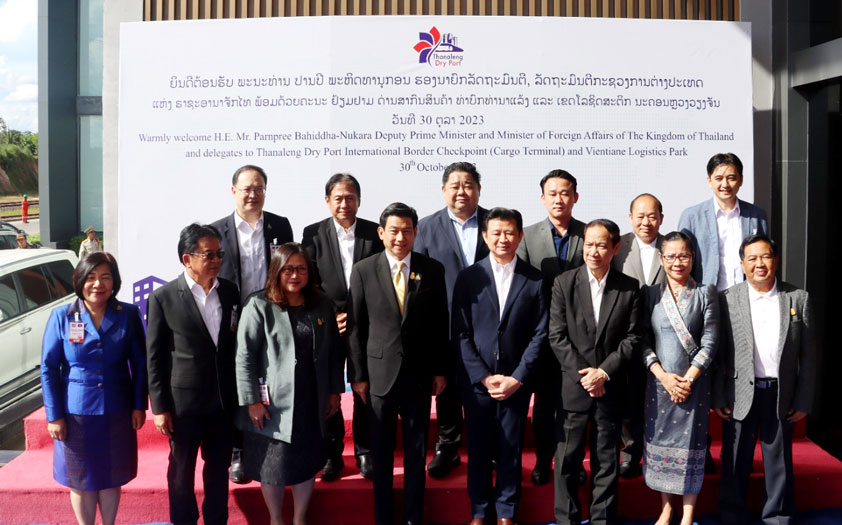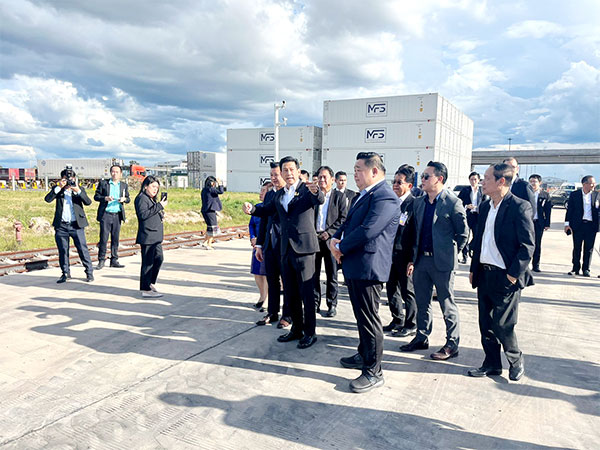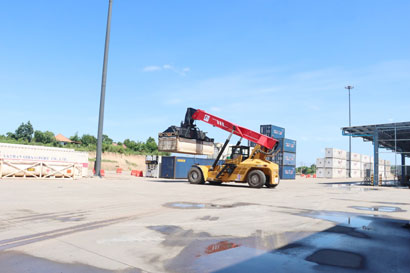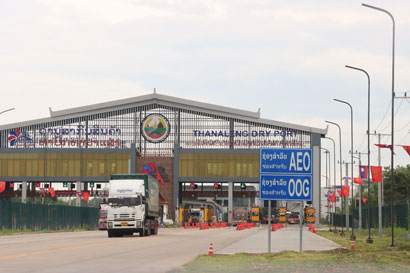 |
| Mr Parnpree Bahiddha-Nukara (fourth left), Mr Chanthone Sitthixay (fifth left) and representatives of both sides gather for group photo. |
Rail transport, logistics services in Laos offer greater opportunity for Thai exporters
Thai exporters are set to enjoy greater benefits from the cost-effective rail transport and logistics services offered by Laos, the developer of the Thanaleng Dry Port and associated Vientiane Logistics Park told Thailand’s Foreign Minister on Monday.
Since the dry port, Laos’ integrated logistics centre, and the Laos-China railway became operational in December 2021, they have significantly lowered transport and logistics costs.
Thai exporters have said they enjoy cost cuts of about 30 percent when shipping goods to China by rail through Laos, compared to road transport.
Costs could potentially drop further, by as much as 50 percent, as more is done to remove unnecessary barriers, the Chairman of the Vientiane Logistics Park Co., Ltd., Chanthone Sitthixay, told the top Thai diplomat.
Thailand’s Deputy Prime Minister and Minister of Foreign Affairs Parnpree Bahiddha-Nukara visited the dry port in Vientiane while accompanying Thai Prime Minister Srettha Thavisin on an official visit to Laos.
More and more Thai businesses are shipping freight through the dry port, which is a converging point between the standard-gauge Laos-China railway and the one-metre-gauge Laos-Thailand railway, according to Mr Chanthone.
Durian exports from Thailand, a major supplier of farm produce, to China through the China-Laos Railway soared by 365 percent in the first five months of 2023, thanks to the shorter transit time and advantages offered by free trade agreements, the Bangkok Post reported.
To better facilitate the shipment of farm produce, the dry port’s developer is working with Chinese authorities to build a sanitary and phytosanitary (SPS) centre at the logistics park to provide a one-stop certification service in Laos that would enable certified goods to enter Chinese markets.
In response to a question raised by the Thai side, Mr Chanthone said he had been to Chengdu, Shenzhen, Guangzhou, and Chongqing to discuss cooperation and expected to sign memorandums of understanding (MOUs) with the operators of dry ports in these Chinese cities, under which empty containers would be provided at a more competitive price in an attempt to further reduce costs.
“In November, we expect to sign three agreements (one each) with Chengdu, Chongqing and Guangzhou,” he said.
Once the agreements are signed, the Thanaleng Dry Port will manage the containers and be responsible for arranging transport for export operators.
“Once the agreements with these three cities are signed, the cost of shipping cargo from Thailand to China will drop sharply - at least by 50 percent,” Mr Chanthone said.
He added that his company has arranged locomotives in stock that can pull freight trains to the transshipment yard located right next to the dry port, instead of using trucks, to enable the direct rail-to-rail transfer of containers and cut costs even more. This service is expected to become operational next year.
Being an important trade gateway between China and Southeast Asia, the Laos-China railway also links to Europe via the China-Europe rail network. From Southeast Asia, cargo can reach European markets within two weeks as opposed to 45 days by sea.
To reach Southeast Asian markets, freight shipped from the multimodal dry port is then moved over a distance of about 700 kilometres to Thailand’s Laem Chabang seaport, about 150km south of Bangkok. From Bangkok, the trade route connects to the Malaysian capital Kuala Lumpur and onwards to Singapore.
The Laos-China railway is part of the planned regional rail network linking China’s Kunming to Singapore through Laos, Thailand and Malaysia.
Thai Prime Minister Srettha Thavisin told Xinhua News Agency recently that Thailand plans to speed up the construction of the China-Thailand railway to link Bangkok to Khon Kaen and Nong Khai across the Mekong River all the way to Laos and China.
On Monday, the Thai premier suggested during talks with his Lao counterpart Sonexay Siphandone that a new railway bridge be built across the Mekong, linking Nong Khai province and Vientiane, according to the Bangkok Post.
Foreseeing the great potential in trade and investment brought by growing connectivity, the developer of the Thanaleng Dry Port is setting up a logistics park to bolster foreign investment. The park includes an export processing zone, logistics park, free trade zone, and technology and halal hub.
Investors benefit from a number of incentives by doing business in Laos, including a corporate tax holiday of 8-16 years and lower Value-Added Tax, with cheap electricity being an added bonus.
Goods manufactured or assembled in Laos also enjoy privileged access to markets in countries whose governments have waived or reduced import tariffs on made-in-Laos products.
More than 30 countries including Australia, Canada, members of the European Union (EU 28), Japan, New Zealand, Norway, Russia, Switzerland and Turkiye have extended such privileges to Laos.
Mr Chanthone told the Thai foreign minister that manufacturers in the logistics park will also enjoy access to markets in the Pacific region through cost-effective services offered by the US$727 million Thanaleng Dry Port and Vientiane Logistics Park, which is part of the Lao Logistics Link project, connecting to Pacific countries through Vietnam.
The Lao Logistics Link project also includes the Vung Ang seaport in Vietnam’s central Ha Tinh province, a planned railway linking Vientiane passing through Khammuan province to Vung Ang, and a planned dry port in Khammuan, bordering Thailand’s Nakhon Phanom province.
“Laos has become a land-link country,” the Vice President of Vientiane Logistics Park Co., Ltd., Tee Chee Seng, said, adding that cargo from Laos could flow to many parts of the world.
“We are currently promoting seamless logistics between the standard gauge and one-metre gauge [railways],” he stated.
By Advertorial Desk
(Latest Update November 1, 2023)
|





